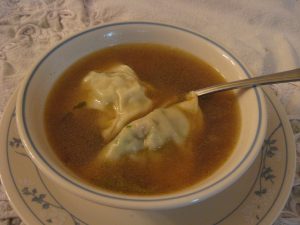 A succulent slice of foie gras. That perfect round shape was produced with an enzyme called transglutaminase – meat glue.
A succulent slice of foie gras. That perfect round shape was produced with an enzyme called transglutaminase – meat glue.
The more I learn about meat glue, the more cheated I feel. Since there’s no law ensuring that I be informed, I could be absorbing blood-clotting enzyme without suspecting it. Transglutaminase is said to be used in meat, fish, poultry, dairy products, pasta, and bread. A post on the Cooking Issues blog, which we quoted in our previous post about meat glue, seems to be the main information resource for the layman. Labels certainly aren’t telling.
Safety isn’t uppermost in consumer’s minds. The outrage which lead to meat glue being banned in the E.U. focused on paying premium prices for inferior foods. Yet how much of the blood-clotting enzyme gets into the bloodstream through the skin – a concern for food workers – or through the mucous membranes when we put glued food in our mouths? Nobody knows.
Meat glue is applied to all kinds of foods, not only meat, poultry and fish. It’s an agent appreciated by the dairy industry because it thickens yogurt and cheese at less cost. According to a study published by the Entrepreneur blog,
” (Meat glue) …can also help in saving ingredient costs by reducing the amount of protein required to create a desirable texture, firmness and stability of yogurt.”
In other words, meat glue allows the manufacturer to economize at the expense of the consumer, who gets less protein in his yogurt but enjoys the mouthfeel of the real thing.
To get a better idea of how meat glue works, I watched a YouTube video of a lecture and demonstrations given by chef Wylie Dufresne, a leader in molecular gastronomy, owner and chef of the prestigious WD-50 restaurant in New York, and winner of culinary prizes. The lecture was given at the Harvard School of Engineering and applied sciences and sponsored by big names like Mars, Whole Foods, the Jose Andres Food Group, and Le Creuset.
A chill went through me as I watched the hour-long video. I saw, with rising disgust, a pale slab of chicken stock that flapped in Dufresne’s hand as if made of rubber. The audience, all sciences students, watched in rapt fascination. Nobody seemed to be thinking how unnatural it is to eat synthetically transformed food.
True, the powder allows chefs to leap to undreamed-of culinary heights. Beef gnocchi! Peanut butter pasta! Campari-flavored tofu! To show how strongly meat glue bonds foods together, chef Dufresne smilingly bounced a stick of glued carrots and celery off the demonstration table, saying, “It’s bullet-proof!”
If you have the time, it’s worth watching the lecture to judge for yourself:
[youtube]http://www.youtube.com/watch?v=D3RsMQKGZm8[/youtube]
In no way do I want to make adepts of molecular gastronomy to be evil people. Chef Dufresne shows an intense intellectual curiosity and sheer joy in food. He himself says that he’s eaten more meat glue than most people ever will – and doesn’t seem any the worse for it.
But doubts linger. What the long-term effects of meat glue are, nobody can say. Another concern is how glued meat is often poached in its plastic wrap. I wonder how much of petrochemicals get cooked into that glued food. Double whammy?
Here is a call for transparency in labeling from the Food Technology blog, India:
“Invariably industry justifies use of these so called meat glues because they are used only during processing and resist declaring it in the label obviously maintaining that it is not a part of the formulation of the product. While technically they are correct, the fact still remains that the so called processing aid stays right there in the final product which certainly requires declaration for the information of the consumer.”
For what the information may be worth, Ajinomoto, the major manufacturer of meat glue, is also the world’s biggest producer of MSG.
It’s very difficult to tell if the food on your plate has been glued. Most people can’t taste transglutaminase. The seams that join disparate pieces of flesh are hardly visible. And a nice, smooth puree could be just that, or a slurry of meat or vegetables made smoother with gelatin and our friend, meat glue.
Suspect perfectly round slices of meat or fish in restaurants and perfectly round logs of beef in the supermarket. Novelty foods, like shrimp noodles or quinoa chips, are surely synthetically bound. In any case, ask the restauranteur or the butcher, and hope they give you an honest answer.
Bottom line: stay away from processed foods. Cook more at home.
More on food safety on Green Prophet:
- Meat Glue: The Food Industry’s Dirty Secret
- The Meat You Eat May Not Be What You Think
- Bactochem Barcodes Your Organic Meat
:: Entrepreneur
Photo from Food Nouveau Blog.




Also, thrombin is banned in the EU. Transglutaminase is not.
Bryan Elliott that you are correct would not make your comment any less verbally aerodynamic, as it would still fly over the head of the person who wrote this article.
It’s anti-meat hysteria at its most hysterical LOL
Just how much is made clear in the sister article linked at the bottom.
“Since there’s no law ensuring that I be informed, I could be absorbing blood-clotting enzyme without suspecting it.”
You could very well be doing that right now. I mean: do you eat meat at all? Because animal blood has transglutaminase _in_ it. It’s blood-clotting enzyme.
Another powerful argument for becoming a vegetarian and enjoying better health than ever before by ridding your body of all those commercial toxins.
Hey I’m glad I heard about this. I have been wondering how Thai fish cakes get that wonderful rubbery texture. I bet they use meat glue. The notion that this is something horrible is absurd.
We’ve been eating it ever since we started eating meat, because animal meat has blood in it, from which this substance was first discovered and purified. It is NOT artificial, though perhaps now they have artificial means of mass production.
Oh and heaven forbid anyone mention this to cultures that enjoy blood sausages.
maybe some are missing the point here..simply, consummers have a right to know what is in their food,as the uk law requires on all food packaging. However there is vulnerability when buying loose meat in a store or eating out, as we do not ask for an ingredients list. Maybe this should be a new law, that ingredients are put on a menu for all items. In this way everyone can decide for themselves if they want to purchase a complete piece of meat or one that has been glued together with additives.
It may or may not cause harm, but we have the right to know exactly what we are buying and putting in our bodies.Passing a patchworked piece of meat off as an original one piece should be unlawful practice.
this man is mad in the head….hope his guts glue together and his anus swells
I agree with Harold (to a point). I think that we, as a society, are willing to accept risks we are used to. I once read a great description of this. It said, in effect, “want to vacation in Israel?” “not me, it’s too dangerous, what with all the terrorism”. In reality, you odds of dying from a terrorist attack on your vacation in the middle east is less than the change you will die in a car accident on the way to the airport. We are just used to one and not the other risk.
As to this issue, we need full disclosure. There is no reason I shouldn’t know what I’m putting into my body. I may still decide to do so but how can you think I don’t have the right to know? The FDA needs to rethink its purpose in the country or it needs to be replaced by an agency that works for us, not industry!
I wonder how much meat glue goes into those perfectly rotund balls of meat called kebabs served in Israel. They are rubbery and don’t fall from the stick. Sounds like a case of meat glue to me. I bet it’s also used in formed burgers found in North America. More investigation is needed. What about handlers of the stuff? What if it isn’t allowed to sit the fixed amount of time needed to bond? Will it bond inside our bodies?
DOES ANYONE THINK THE FDA REALLY CARES???? THIS IS AN OUTRAGE!
THANKS KARIN & MICKEY FOR SETTING HAROLD STRAIGHT!
Great! As a person with Gluten Intolerance…. I usually meat dishes with relish knowing that I am unable to enjoy the bread products served to me. Now, I have to sniff around meat products served to me. This is scarey that person with certain allergies such as gluten/wheat can become seriously ill because they ate something they did not realise was injurous to them. This “meat glue” also contains the factors normally found in blood that cause our blood to clot. Factor VIII for one. What if one is allergic to this? bad bad bad stuff.
Leave our steaks alone!!!!
“A succulent slice of foie gras. Makes your mouth water? ”
No. California has banned production because its production is sickening.
Maybe best served with a nice side of shark fin soup, hmmm?
My father had a meat store back in the fifties, when I first heard about making meat red by the use of chemicals.
I thought then it was outlawed in the USA.
Is it leagal in the states now ?
Harold, you need to get your head out of the sand. These things are actually happening and has been proven. All they know how to do anymore is poison our food for the sake of money. We don’t accept 50,000 deaths a year, but can you solve this problem? If so I would like to know how. We care very much, but soon all this will be stopped by some one more powerful. Man has ruined the earth along with it’s food supplies. Karin, you are so right, but we don’t know anymore. The sooner we can grow our own food including meat supplies, the better it will be for us, at least we will know what is in it.
Harold, this issue here is about food transparency. Consumers need to know what’s in their food. Period.
OH!!! Please!!! What misguided concern… You speculate on things you know absolutely nothing about, looking for anything to hate and correct, but think nothing of climbing into your car to go to dinner, and stand the best chance in your life of dying in that car because of the very real and high risk of becoming a traffic fatality. If a food caused fifty thousand deaths a year, you probably wouldn’t eat it… But would you spend the calories preaching against it like you do with bitching about processed food? You accept 50,000 deaths a year without any further consideration, but let some food ingredient enter the food chain that you can condemn out of ignorance, and we are off to the races… Let’s spread mindless rumors, and speculate on things that can produce fear and loathing. Who cares if our creative story telling is based in anything resembling fact. We can use subjects like “Meat Glue” to bring us closer together in a bond of hate and disgust. It is a far greater good to keep one’s mouth shut and open one’s mind to search and seek out and receive the facts of a thing, until the safety of an issue is determined by those who honestly work the potential problem, silently… Be concerned by what you eat, but do it with intelligence…
Two things: I’m so glad I don’t eat hoofed animals, and I think I’ll go back to no meat at all.
This meat glue is an outrage, and every American needs to know this, because this would explain why a lot of people are getting obese.
I have been working in the industry for the past 16 years and have had the privaledge of working in some of Londons finest establishements. I will not mention them in my response to your article however, i disagree with your comments regarding the main photo above (foie gras terrine)
I have made foie gras ballontine/ terrines 100’s of times and have NEVER used meat glue. I dont deny that it is used in the industry but i can easily form a PERFECT circular shape with fois gras using cling film and nothing else.
Foie gras is left to reach room temperature and de-veined, soaked in sauternes and cooked at a very low temperature. Then placed in a double thick layer of cling film and rolled in to a long sausage shape.
This is then compressed by wrapping cling film along each end compressing the contents then set in the fridge for 24 hours. Once chilled you can slice and remove the cling film.
As I have mentioned, I am not saying that meat glue isnt used in the industry, I just hate that general assumptions are made towards dishes that are created by talented chefs, ‘pointing the finger’ implying chemical addatives are being used in kitchens without the customers knowledge.
Ben